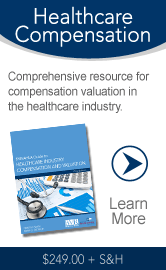 |
 |
Issue #23-1 | April 23, 2014

Hospitals look to outpatient facilities for growth Hospital M&A activity is expected to be strong this year, but hospitals are shifting their sights. Up to now, much of the focus has been on acquiring inpatient, acute-care hospitals, but these are no longer the "money makers" of a health system. Instead, large outpatient centers and other clinical integration groups have become bigger pieces in the M&A game, according to a new white paper from financial advisory firm Ponder & Co. The report also reveals that:
Note: The valuation of outpatient facilities is covered in the BVR/AHLA Guide to Healthcare Valuation, which includes chapters on valuing ambulatory surgical centers, dialysis clinics, and imaging centers. ASC valuation multiples are on the rise Buyers are paying higher multiples for controlling interests in ambulatory surgery centers (ASCs), according to the 2014 ASC Valuation Survey from HealthCare Appraisers Inc. Twenty-five respondents, representing well over 500 ASCs throughout the country, responded to this year’s survey. Single specialty: When purchasing a controlling interest in a single-specialty ASC, 70% of the respondents reported prevailing valuation multiples of 6.0 to 7.9 times EBITDA, while 30% reported lower valuation multiples ranging from 4.0 to 5.9 times EBITDA. This is comparatively higher than in the previous survey, in which 57% of respondents reported valuation multiples of 6.0 to 7.9 times EBITDA for controlling interests in single-specialty ASCs, while 43% reported lower valuation multiples ranging from 3.0 to 5.9 times EBITDA. Multispecialty: When purchasing a controlling interest in a multispecialty ASC, 78% of the respondents reported prevailing valuation multiples of 6.0 to 8.0 times EBITDA, while 22% reported lower valuation multiples ranging from 4.0 to 5.9 times EBITDA. The current survey indicates that multiples are comparatively higher than the previous survey. According to the current survey, 57% of respondents reported multiples of 7.0 to 8.0 times EBITDA for controlling interests in multispecialty ASCs, versus 50% in the prior survey. Acquisition activity is expected to remain high this year, as 68% of respondents plan to purchase between one and five ASCs, 16% plan to purchase between six and 10 ASCs, and 4% plan to purchase 16 ASCs or more. Twelve percent of respondents are not planning to purchase a multispecialty ASC over the next 12 months. ASC valuation webinar: Get some insight from a recent webinar, Valuing Ambulatory Surgical Centers, featuring Todd Sorensen and Kevin McDonough (both VMG Health), two veteran valuation experts in this field. New five-star ranking system for hospitals Although not officially announced, CMS has confirmed that it is developing a five-star rating system for hospitals and for home health and dialysis providers, according to a report in HealthLeaders Media. CMS currently uses a rating system for nursing homes. The rankings will be displayed on the “Compare” websites (Hospital Compare, Physician Compare, Nursing Home Compare, and so on) from CMS. The new system will start either at the end of this year or the beginning of 2015. Very little information is coming out of the CMS about the new ranking system, so providers need to have an open dialogue with the agency about the details and the timing of the new system. Weak growth persists at for-profit hospitals For-profit hospital companies posted very weak organic growth in volumes in the fourth quarter of 2013, and it’s likely that this trend will continue, according to a new report from Fitch Ratings. The Fitch-rated group of hospitals reported admissions and adjusted admissions dropping 4.7% and 2.0%, respectively, on average. Fitch does not expect a strong recovery when the industry reports results for the first quarter of 2014. Good news (maybe): There are some positive trends, the report points out. Health insurance exchanges enrolled more individuals than expected. Also, hospitals have seen a higher acuity patient mix, which has helped improve net revenue per adjusted admission. However, Fitch says not to take these trends too seriously because "the actual influence of the insurance expansion on hospital industry operating trends is far from certain, since the effects of narrow networks, employer dumping and incremental utilization by the previously uninsured are still unknowns." Fitch also reports that most companies are operating with higher leverage in early 2014 versus the previous years' levels, largely due to the effects of funding of acquisitions. The negative influence on credit profiles is tempered, since recent transactions are expected to contribute to EBITDA and cash flow growth, offsetting the implications of higher cash interest expense. Otherwise, the liquidity profile of most companies in the hospital segment is solid. Companies have adequate liquidity or capital market access to address near-term debt maturities, and compliance with debt agreement financial maintenance covenants is not a concern. The full report, Hospitals' Credit Diagnosis: Consolidation Supports Growth in a Weak Organic Operating Environment, is available at www.fitchratings.com. The report provides a summary of the quarterly operating performance and credit metrics of companies in the for-profit hospital sector, including detailed debt and organizational structure charts. More providers using NPPs to cut costs To deliver care in a value-based environment and to address the issue of physician shortage, healthcare organizations are relying more on nonphysician providers (NPPs). According to a new MGMA analysis Nonphysician Provider Utilization in the Future of US Healthcare, during the past 15 years, medical practices have increased their use of NPPs. Since 2008, the number of full-time-equivalent (FTE) NPPs per FTE physician increased by 11%, from 0.27 to 0.30 in multispecialty practices. Cardiology, family medicine, and orthopedic surgery practices have reported an increase in the use of NPPs over the past five years. Prices jump for skilled nursing facilities The average price paid for skilled nursing facilities rose to a record $73,300 per bed in 2013, according to the 2014 Senior Care Acquisition Report from Irving Levin Associates. This price represents a 21% increase over the prior year’s average price. The previous record, set in 2010, was $62,500 per bed. Average cap rates for skilled nursing facilities, the most common valuation metric, stayed within historical norms at 13.0%. “While we were surprised by the significant jump in the average skilled nursing facility price per bed, we had been seeing all year a higher number of skilled nursing facilities on the market that catered to a much higher acuity mix, or were in markets that had the potential for higher acuity, and that is what the buyers want,” according to Stephen M. Monroe, the report’s editor. “The value of Medicare and Managed Care beds is much higher than Medicaid beds, so when they make up a larger proportion of a nursing facility’s census, demand and value increases,” he says. Webinars of interest BVR is conducting an Online Symposium on Healthcare Valuation, which focuses on the challenges inherent in valuations in medicine, life sciences, and healthcare. Here are some upcoming webinars in this series:
|
|
||||||
1000 SW Broadway, Suite 1200, Portland, OR 97205
(503) 291-7963 | editor@bvhealthcarenews.com
BVResources.com/healthcare

